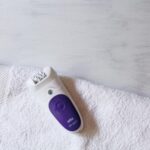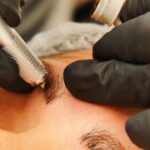Epilator pain can be a concern for many, but by following tips to reduce discomfort and caring for your skin properly, the pain can become more manageable. Additionally, building up a tolerance to epilator pain can make the process less daunting over time.

Factors that influence epilator pain levels
Everyone’s experience with epilator pain is different, and there are several factors that can influence the pain levels. These factors include individual pain tolerance, hair type and thickness, the area being epilated, and the type of epilator used. Understanding these factors can help you prepare for and potentially reduce the pain associated with epilation.
Individual pain tolerance
Everyone has a different pain threshold, which means that some people may find epilation more painful than others. If you have a low pain tolerance, it is important to take steps to make the process more comfortable. You can try using numbing creams, deep breathing techniques, or other forms of distraction to help manage the pain.
Hair type and thickness
The thickness and coarseness of your hair can also affect the level of pain experienced during epilation. People with thicker, coarser hair may experience more discomfort, as the epilator has to work harder to remove the hair. In such cases, it might be helpful to trim the hair before epilating, or use a wet epilator that can be used in the shower, as water can help to soften the hair and make it easier to remove.
Area being epilated
The level of pain experienced during epilation can also depend on the area being treated. Certain areas of the body, such as the face, underarms, and bikini line, are more sensitive and may cause more discomfort when epilated. To minimize pain in these areas, try using a smaller epilator head designed specifically for sensitive areas and ensure the skin is clean and dry before beginning.
Type of epilator used
Different epilators come with various features that can help to minimize pain during the process. For example, some epilators have multiple speed settings, allowing you to choose a slower speed for more sensitive areas. Others have a built-in skin guard to prevent the skin from being pinched by the epilator’s tweezers. Choosing an epilator with features designed to reduce pain can help make the process more comfortable.
Remember, epilator pain varies from person to person and is influenced by factors such as pain tolerance, hair type, the area being epilated, and the type of epilator used.
Table 1: Factors that Influence Epilator Pain Levels
| Factor | Description | Tips to Reduce Pain |
|---|---|---|
| Individual pain tolerance | Some people have a higher pain threshold than others, making epilation less painful for them. | Use numbing cream, deep breathing, or distraction techniques. |
| Hair type and thickness | Coarser and thicker hair can cause more discomfort during epilation. | Trim hair before epilating, or use a wet epilator. |
| Area being epilated | Sensitive areas like the face, underarms, and bikini line may be more painful to epilate. | Use a smaller epilator head, and ensure skin is clean and dry. |
| Type of epilator used | Different epilators have features designed to reduce pain, such as multiple speed settings or skin guards. | Choose an epilator with pain-reducing features. |
Caption: A summary of factors that influence epilator pain levels and tips to reduce pain.
“The level of pain experienced during epilation varies from person to person and depends on factors such as individual pain tolerance, hair type, the area being epilated, and the type of epilator used.”
Comparing epilator pain to other hair removal methods
Epilator pain levels can vary, but it is helpful to compare epilator pain to that of other common hair removal methods.
Shaving
Shaving is generally considered to be the least painful hair removal method, as it only cuts the hair at the skin’s surface. However, it can cause skin irritation and razor bumps, and the results are short-lived since hair grows back quickly.
Waxing
Waxing is often considered more painful than using an epilator, as it involves quickly ripping out hair from the root. The pain is typically intense but short-lived. However, waxing can provide longer-lasting results compared to shaving.
Hair removal creams
Hair removal creams, also known as depilatory creams, are generally painless, but they can cause skin irritation or allergic reactions in some individuals. These creams work by dissolving the hair at the skin’s surface, and the results last slightly longer than shaving but not as long as waxing or epilating.
Laser hair removal
Laser hair removal is often described as feeling like a rubber band snapping against the skin. The pain level can vary, but it is generally considered less painful than waxing and more painful than shaving. Laser hair removal provides long-term results, as it targets the hair follicle and prevents or slows down future hair growth.
Table 2: Comparing Epilator Pain to Other Hair Removal Methods
| Hair Removal Method | Pain Level | Potential Side Effects | Duration of Results |
|---|---|---|---|
| Shaving | Low | Skin irritation, razor bumps | Short-lived |
| Waxing | High | Skin irritation, ingrown hairs | Long-lasting |
| Hair Removal Creams | Low | Skin irritation, allergic reactions | Medium-duration |
| Laser Hair Removal | Medium | Skin irritation, burns | Long-term |
| Epilating | Medium | Skin irritation, ingrown hairs | Long-lasting |
Caption: A comparison of epilator pain levels to other hair removal methods.
Tips for reducing epilator discomfort
1. Exfoliate your skin
Exfoliating your skin involves gently rubbing a scrub or using a brush to remove dead skin cells from the surface. This helps to keep your skin smooth and prevents the buildup of dead skin cells that can lead to ingrown hairs. By exfoliating before epilating, you can reduce the chances of hair breakage and minimize discomfort.
“Exfoliating before epilating can help to reduce discomfort and improve overall hair removal results.”
2. Trim longer hairs
Longer hairs can be more painful to remove with an epilator. By trimming your hair to a shorter length (about 1/4 inch), you can make the process less painful. This also ensures that the epilator can effectively grab and remove the hairs.
3. Take a warm shower
Taking a warm shower before epilating can help to open your pores and soften your skin, making hair removal less painful. Avoid using hot water, as this can irritate your skin.
4. Hold your skin taut
When using an epilator, it’s important to hold the skin taut to help the device glide more smoothly and reduce pain. This also ensures that the hairs are removed more effectively.
5. Use a numbing cream
If you find epilating particularly painful, you can try applying a numbing cream to the area before you begin. This can help to reduce discomfort during the process. Be sure to follow the instructions on the product and test a small patch of skin first to ensure you don’t have an adverse reaction.
6. Start on a lower speed setting
Most epilators have multiple speed settings. If you’re new to epilating or find it painful, start on the lowest setting and gradually increase the speed as you become more comfortable.
7. Epilate in the direction of hair growth
To minimize discomfort, epilate in the direction of hair growth. This can help to reduce the chances of hair breakage and ingrown hairs.
8. Practice deep breathing and relaxation techniques
Taking deep breaths and practicing relaxation techniques can help to reduce pain and discomfort during epilation. Focus on your breathing and try to stay calm and relaxed throughout the process.
Table 3: Tips for Reducing Epilator Discomfort
| Tip | Description |
|---|---|
| 1. Exfoliate your skin | Remove dead skin cells to reduce ingrown hairs and make the process smoother |
| 2. Trim longer hairs | Trim hair to about 1/4 inch to make the process less painful and more effective |
| 3. Take a warm shower | Softens skin and opens pores, making hair removal less painful |
| 4. Hold your skin taut | Helps the device glide more smoothly and ensures more effective hair removal |
| 5. Use a numbing cream | Apply before epilating to reduce discomfort |
| 6. Start on a lower speed setting | Begin on the lowest setting and gradually increase as you become more comfortable |
| 7. Epilate in the direction of hair growth | Reduces chances of hair breakage and ingrown hairs, minimizing discomfort |
| 8. Practice deep breathing and relaxation techniques | Helps to reduce pain and discomfort during epilation |
Caption: Table 3 provides a summary of tips to reduce discomfort while using an epilator.
How to Choose the Right Epilator for Your Pain Tolerance
When choosing an epilator, it’s essential to consider your pain tolerance and needs. By selecting the right device, you can minimize discomfort and make the process more manageable. Here are some factors to consider when shopping for an epilator:
1. Wet and dry functionality
Some epilators are designed for use in both wet and dry environments. Using an epilator in the shower or bath can help reduce pain as the warm water relaxes your skin and softens the hair.
2. Number of tweezers
Epilators come with various numbers of tweezers, which can impact the level of pain. More tweezers mean faster hair removal, but it may also cause more discomfort. If you have a low pain tolerance, consider an epilator with fewer tweezers.
“An epilator with fewer tweezers may be less painful but may require more time to cover the same area. It’s crucial to find the right balance between efficiency and pain tolerance.”
3. Speed settings
Choose an epilator with multiple speed settings, as it allows you to start on a slower speed and gradually increase as you become more comfortable.
4. Built-in features for pain reduction
Some epilators come with features specifically designed to reduce pain, such as massaging rollers or cooling attachments. These can help alleviate discomfort during the process.
5. Size and ergonomics
Consider the size and ergonomics of the epilator. A smaller device may be easier to maneuver and control, while a larger one may cover more area quickly but could be more challenging to handle.
Table 4: Factors to Consider When Choosing an Epilator
| Factor | Description |
|---|---|
| 1. Wet and dry functionality | Allows for use in the shower or bath to reduce pain |
| 2. Number of tweezers | Fewer tweezers may be less painful but slower; more tweezers may be faster but more painful |
| 3. Speed settings | Provides control over the epilation process |
| 4. Built-in features for pain reduction | May include massaging rollers or cooling attachments to alleviate discomfort |
| 5. Size and ergonomics | Affects ease of use and control |
Caption: Table 4 outlines factors to consider when choosing an epilator for your pain tolerance.
First-Time Epilator Users: What to Expect
If you’re using an epilator for the first time, it’s essential to know what to expect and prepare yourself for the experience. Here’s a breakdown of what you might experience during your first epilation session:
1. Initial discomfort
First-time epilator users will likely experience some discomfort, as the sensation of multiple hairs being pulled out simultaneously can be jarring. This discomfort will generally decrease over time as you become more accustomed to the process.
“The first time using an epilator can be uncomfortable, but with patience and practice, the sensation will become more manageable.”
2. Redness and irritation
It’s common for your skin to become red and irritated after using an epilator, especially for the first time. This reaction should subside within a few hours or overnight.
3. Ingrown hairs
Epilating can sometimes cause ingrown hairs, particularly in individuals prone to them. Exfoliating regularly can help prevent this issue.
4. Slower hair regrowth
One of the benefits of epilating is that it takes longer for hair to grow back compared to shaving. Over time, you may notice that the hair becomes finer and less noticeable.
Table 5: What to Expect as a First-Time Epilator User
| Expectation | Description |
|---|---|
| 1. Initial discomfort | Discomfort during the first session, which usually lessens with subsequent uses |
| 2. Redness and irritation | Common reactions that should subside within a few hours or overnight |
| 3. Ingrown hairs | Can be prevented with regular exfoliation |
| 4. Slower hair regrowth | Hair grows back slower and may become finer over time |
Caption: Table 5 summarizes what first-time epilator users can expect during their initial epilation experience.
Building Up Tolerance for Epilator Pain
As with many things, practice makes perfect. Over time, you can build up a tolerance for the discomfort associated with epilation. Here are some tips to help you adjust to the sensation and minimize pain:
1. Start with a lower-speed setting
Begin with the lowest speed setting on your epilator to ease into the process. As you grow more comfortable, you can gradually increase the speed.
2. Epilate in short, consistent sessions
By consistently using your epilator in short sessions, you’ll give your skin time to adjust to the sensation. This approach can also help reduce the risk of irritation.
“Consistency is key when building tolerance for epilator pain. Regular, short sessions can make the process more manageable over time.”
3. Use a numbing cream
Applying a numbing cream or gel to the area you plan to epilate can help minimize discomfort. Be sure to follow the product’s instructions and apply it only to the specific areas you’ll be epilating.
4. Practice deep breathing and relaxation techniques
Focusing on your breath and employing relaxation techniques can help you manage discomfort during epilation. Deep, slow breaths can help you stay calm and relaxed throughout the process.
Table 6: Tips for Building Up Tolerance for Epilator Pain
| Tip | Description |
|---|---|
| 1. Start with a lower-speed setting | Begin with the lowest speed setting and gradually increase as you become more comfortable |
| 2. Epilate in short, consistent sessions | Regular, short sessions help your skin adjust to the sensation and reduce irritation |
| 3. Use a numbing cream | Apply a numbing cream or gel to minimize discomfort |
| 4. Practice deep breathing and relaxation techniques | Focusing on your breath can help you stay calm and manage discomfort during epilation |
Caption: Table 6 provides tips for building up tolerance to epilator pain over time.
How to Care for Your Skin After Epilating
Caring for your skin after epilating is essential for minimizing discomfort and promoting healthy skin. Here are some steps you should take after using an epilator:
1. Cleanse the skin
After epilating, gently cleanse the treated area with a mild soap and warm water to remove any dead skin cells and bacteria. This will help prevent irritation and infection.
2. Apply a soothing lotion or cream
Using a soothing lotion or cream with ingredients like aloe vera or chamomile can help calm your skin and reduce redness and irritation.
“Applying a soothing lotion or cream after epilation can help calm the skin and minimize discomfort.”
3. Avoid tight clothing
Tight clothing can rub against freshly epilated skin, causing irritation. Opt for loose, comfortable clothing for the first 24 hours after epilating.
4. Exfoliate regularly
Exfoliating your skin a few times a week can help prevent ingrown hairs and keep your skin smooth. Use a gentle exfoliating scrub or a dry brush to remove dead skin cells.
5. Avoid sun exposure
Freshly epilated skin can be more sensitive to the sun. Limit sun exposure for 24 hours after epilating and apply sunscreen when going outside.
Table 7: Tips for Caring for Your Skin After Epilating
| Tip | Description |
|---|---|
| 1. Cleanse the skin | Gently cleanse the treated area with a mild soap and warm water |
| 2. Apply a soothing lotion or cream | Use a soothing lotion or cream with ingredients like aloe vera or chamomile |
| 3. Avoid tight clothing | Opt for loose, comfortable clothing for the first 24 hours after epilating |
| 4. Exfoliate regularly | Exfoliate your skin a few times a week to prevent ingrown hairs and keep your skin smooth |
| 5. Avoid sun exposure | Limit sun exposure for 24 hours after epilating and apply sunscreen when going outside |
Caption: Table 7 outlines steps to care for your skin after epilating to minimize discomfort and promote healthy skin.
Key Takeaways
- Epilator pain varies from person to person and can be influenced by factors like hair type, skin sensitivity, and pain tolerance.
- Comparing epilator pain to other hair removal methods can help put the level of discomfort in perspective.
- Tips for reducing epilator discomfort include exfoliating beforehand, using a numbing cream, and epilating after a warm shower.
- Choosing the right epilator based on your pain tolerance can make a difference in your overall experience.
- First-time epilator users should expect some discomfort but can build up a tolerance over time.
- Proper skin care after epilating is essential to minimize discomfort and promote healthy skin.
Conclusion
Epilator pain can be a concern for many, but by following tips to reduce discomfort and caring for your skin properly, the pain can become more manageable. Additionally, building up a tolerance to epilator pain can make the process less daunting over time. Remember to choose the right epilator for your pain tolerance and take care of your skin after each session.








